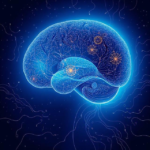Have you ever found yourself waking up unable to move, speak, or even scream — all while feeling a heavy presence in the room? Perhaps you’ve experienced horrifying nightmares that blur the line between dreams and reality. These frightening experiences are more common than you might think and are often linked to sleep paralysis and nightmares.
In this blog post, we’ll explore the science, symptoms, causes, and solutions for sleep paralysis and nightmares. We’ll also offer practical tips for better sleep hygiene, ways to prevent these phenomena, and when to seek professional help.
What is Sleep Paralysis?
Sleep paralysis is a temporary inability to move or speak while falling asleep or waking up. Despite being awake mentally, your body remains in a sleep-like state. It typically occurs during the REM (Rapid Eye Movement) phase of sleep, when most vivid dreaming happens.
Key Symptoms:
Inability to move or talk
A feeling of being suffocated or choked
Hallucinations (visual, auditory, or tactile)
Intense fear or dread
A sense of a presence in the room
Most episodes last from a few seconds to a couple of minutes and resolve on their own, but they can be terrifying.
What Are Nightmares?
Nightmares are intense, disturbing dreams that often wake you from sleep, usually during REM sleep. Unlike general bad dreams, nightmares can leave lasting feelings of fear, anxiety, or sadness.
Common Characteristics of Nightmares:
Themes of danger, falling, being chased, or death
Emotional distress after waking
Difficulty going back to sleep
Frequent awakenings disrupting sleep patterns
Nightmares are common in both children and adults, but frequent or recurring nightmares may signal a deeper issue.
What Causes Sleep Paralysis?
1. Sleep Deprivation
Lack of sleep disrupts normal sleep cycles and increases the risk of entering REM sleep directly from wakefulness — a state that may trigger paralysis.
2. Irregular Sleep Schedules
Frequent changes in bedtime or shift work can interfere with circadian rhythms, making REM sleep unpredictable.
3. Sleep Disorders
Conditions like narcolepsy, insomnia, and sleep apnea are often associated with sleep paralysis.
4. Mental Health Issues
Anxiety, PTSD, and depression are known to increase the likelihood of both sleep paralysis and nightmares.
5. Sleeping Position
People who sleep on their backs are more prone to sleep paralysis episodes.
6. Substance Use
Caffeine, alcohol, and certain medications can disrupt sleep architecture.
Causes of Nightmares
While some causes overlap with sleep paralysis, nightmares have their own specific triggers.
1. Stress and Anxiety
Everyday stress, unresolved trauma, or major life changes can manifest as disturbing dreams.
2. Trauma and PTSD
Nightmares are a common symptom of Post-Traumatic Stress Disorder (PTSD) and may include flashbacks or reenactments.
3. Sleep Disorders
Sleep apnea, restless leg syndrome, and other disturbances can fragment REM sleep, leading to nightmares.
4. Medications
Certain antidepressants, blood pressure medicines, or withdrawal from drugs like benzodiazepines can lead to vivid nightmares.
5. Late-Night Eating
Eating just before bed can raise metabolism and brain activity, which may provoke nightmares.
Are Sleep Paralysis and Nightmares Dangerous?
While not physically harmful, both experiences can significantly impact mental health. Recurrent episodes may lead to:
Sleep anxiety or insomnia
Daytime fatigue
Reduced productivity
Emotional distress
Fear of sleeping
In rare cases, chronic sleep paralysis may be a symptom of underlying neurological or psychological conditions.
Cultural Interpretations of Sleep Paralysis
Sleep paralysis has been misunderstood across cultures for centuries. Many ancient beliefs attribute it to supernatural forces:
India & Nepal: Ghostly possession (referred to as “chudail” or “bhoot”).
Japan: Known as Kanashibari, meaning “bound in metal” by spirits.
Africa: Seen as a demonic attack or witchcraft.
Europe: The “night hag” – a demonic figure sitting on the chest.
While fascinating, these explanations often exacerbate fear, especially in people already experiencing sleep disorders.
Lucid Dreaming vs Sleep Paralysis
Some individuals learn to turn sleep paralysis into a lucid dreaming opportunity, using the moment of awareness to direct their dreams consciously. This takes training and practice through methods such as:
Reality checks during the day
Dream journaling
Mindfulness and meditation before sleep
However, this is not recommended for those with frequent sleep anxiety or trauma-related nightmares.
How to Stop Sleep Paralysis and Nightmares
1. Establish a Regular Sleep Routine
Go to bed and wake up at the same time every day, even on weekends.
2. Improve Sleep Hygiene
Avoid caffeine and heavy meals 3 hours before bedtime.
Keep your bedroom dark, cool, and quiet.
Limit screen time before bed.
3. Manage Stress and Anxiety
Practice meditation, deep breathing, or yoga.
Journaling or talking about your fears can help reduce their recurrence in dreams.
4. Avoid Sleeping on Your Back
Try sleeping on your side or stomach, as this reduces the chances of sleep paralysis.
5. Limit Alcohol and Drug Use
Both recreational and prescription drugs can interfere with REM sleep.
6. Use Grounding Techniques During an Episode
If you feel a sleep paralysis episode starting:
Try wiggling your fingers or toes.
Focus on slow, deep breathing.
Mentally remind yourself, “This will pass.”
When Should You See a Doctor?
While occasional episodes are normal, consult a healthcare provider if:
You experience sleep paralysis or nightmares more than once a week.
Your sleep is constantly disrupted.
You have symptoms of depression, PTSD, or anxiety.
You snore heavily or gasp during sleep (possible sign of sleep apnea).
A sleep study or referral to a sleep specialist can help diagnose deeper issues and suggest treatments like:
Cognitive Behavioral Therapy for Insomnia (CBT-I)
Anti-anxiety or antidepressant medications
CPAP machines (for sleep apnea)
Trauma therapy (if linked to PTSD)
Natural Remedies and Alternative Approaches
1. Herbal Teas
Chamomile, valerian root, and lavender tea can calm the mind and promote deep sleep.
2. Aromatherapy
Essential oils like lavender, cedarwood, or sandalwood may reduce anxiety before bed.
3. Magnesium Supplements
Magnesium supports muscle relaxation and nervous system regulation. Always consult your doctor before starting supplements.
4. Sleep Affirmations
Positive affirmations before bed can reshape subconscious fears:
“I am safe as I sleep.”
“I release the day and rest peacefully.”
“My dreams are calm and healing.”
FAQs About Sleep Paralysis and Nightmares
Q1: Is sleep paralysis a sign of mental illness?
Not necessarily. While it can be linked to anxiety or PTSD, most people experience it once or twice without any lasting issues.
Q2: Can children experience sleep paralysis?
Yes, although it’s less common than in adults. Nightmares and night terrors are more frequent in children.
Q3: Are nightmares and night terrors the same?
No. Nightmares occur during REM sleep and are remembered, while night terrors occur in non-REM sleep and involve screaming, flailing, and amnesia of the event.
Final Thoughts
Sleep paralysis and nightmares can be frightening, but they are often manageable with better sleep habits, stress management, and self-awareness. Understanding the scientific basis of these phenomena helps replace fear with control. With proper care, lifestyle changes, and — when needed — professional help, restful and peaceful sleep is absolutely within reach.
If you’re struggling with recurring episodes, don’t hesitate to consult a sleep specialist. Sleep is not a luxury; it’s a foundation of mental, physical, and emotional well-being.
Related posts:
 Unlocking the Secrets of Sleep: How Sleep Physiology Shapes Brain Function
Unlocking the Secrets of Sleep: How Sleep Physiology Shapes Brain Function
 Best Foods & Drinks for Sleep: Improve Your Sleep Naturally
Best Foods & Drinks for Sleep: Improve Your Sleep Naturally
 New COVID-19 Variant 2025: Symptoms, Spread, and Safety Measures You Must Know
New COVID-19 Variant 2025: Symptoms, Spread, and Safety Measures You Must Know
 Impact of Blue Light & Screen Time on Eye Health and Sleep | Digital Wellness Tips
Impact of Blue Light & Screen Time on Eye Health and Sleep | Digital Wellness Tips
 10 Easy Ways to Make Your Lifestyle More Eco-Friendly in 2025
10 Easy Ways to Make Your Lifestyle More Eco-Friendly in 2025
 The Role of Gut Microbiome in Overall Health: The Hidden Ecosystem Within You
The Role of Gut Microbiome in Overall Health: The Hidden Ecosystem Within You
